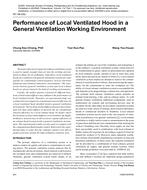Description
The major function of a general exhaust ventilation system is used to supply enough clean air into the working environments to dilute the air pollutants. Sometimes, local ventilated hoods are combined with general ventilation systems for some specific air contaminant control purposes, such as electronic industrial and chemical laboratory environments. The interaction between general ventilation system and local exhaust hood was always found in the kind of working environments.
Usually, the airflow pattern consisted by different locations of inlet/outlet diffusers may influence the performance of local ventilated hoods. Therefore, an experimental study was conducted to investigate air contaminant removal efficiency by a local ventilated hood installed inside a general ventilation environment. The location of inlet diffuser played a more dominant role than outlet diffuser in decision the air contaminant removal efficiency by a local exhaust hood. No matter where the locations of inlet/outlet diffusers were installed, the higher turbulence intensity may result in a lower capture efficiency of an exhaust hood located inside a general ventilation environment. The experimental results are also used to compare with the computational fluid dynamic model. Referred to the experimental data, it seems that the computer model is not able to predict precisely around the high turbulence intensity area.
Units: SI
Citation: ASHRAE Transactions, vol. 114, pt. 1, New York 2008
Product Details
- Published:
- 2008
- Number of Pages:
- 7
- File Size:
- 1 file , 1.7 MB
- Product Code(s):
- D-NY-08-052




